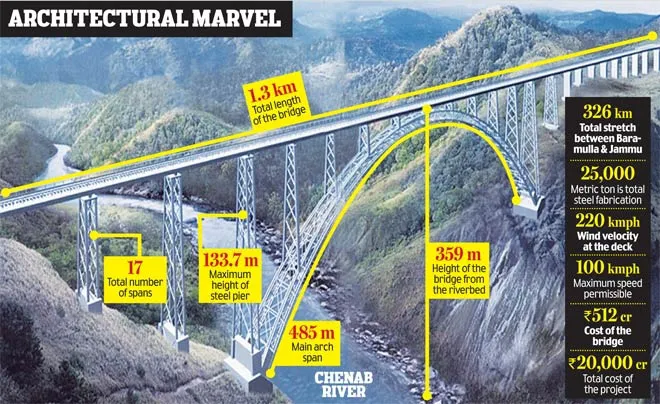10 important points about World’s highest railway bridge ‘Chenab bridge’ Jammu Kashmir
World’s highest railway bridge ‘Chenab bridge’: The Chenab Rail Bridge is an Indian railway steel and concrete arch bridge between Bakkal and Kauri in the Reasi district of Jammu and Kashmir, India. The bridge spans the Chenab River at a height of 359 m (1,178 ft) above the river, making it the world’s highest rail bridge.
In April 2021, the Chenab Rail Bridge’s arch was completed and the overall bridge was completed in August 2022. It is expected to open to rail traffic in December 2022.
10 important points about World’s highest railway bridge ‘Chenab bridge’
#1) The Chenab bridge is 1,315 metre long. The bridge forms a crucial link in the 111-km stretch from Katra to Banihal, which is part of the Udhampur-Srinagar-Baramulla section of the Kashmir Railway project.
#2) More than 1,300 workers and 300 engineers have been working round the clock to complete the bridge.
#3) It will be the highest Railway Bridge in the world being 359m above the river bed level. The Chenab Bridge will be 35 meters higher than the iconic Eiffel Tower in Paris (France).
#4) The construction of the bridge involved the fabrication of 28,660 MT steel, 10 Lakh Cum Earthwork, 66,000 Cum Concrete, and 26 Km motorable roads.
#5) The arch of the bridge consists of steel boxes. The overall weight of the arch is 10,619 MT.
#6) The Chenab Bridge is designed to withstand high wind speed up to 266 Km/Hour.
#7) The Chenab Bridge will remain operational at a restricted speed of 30 Km/Hour
#8) As per the Centre, the Chenab Bridge is being built at ₹1,486 crore.
#9) The Design life of the bridge is at least 120 years.
#10) Approximately 584 Km of welding was done to join the different parts of the structure, which is to the tune of the distance between Jammu Tawi to New Delhi.
Construction Starting
The Chenab Rail Bridge was originally intended to be completed in December 2009. However, in September 2008, the project was halted due to fears over the bridge’s stability and safety. Work on the bridge restarted in 2010, with the plan to complete it in 2015.
Design and Technology
The design and construction was awarded to Afcons Infrastructure, a part of the Shapoorji Pallonji Group, the third-largest construction group in India, with the help of IISc Bangalore. Major construction decisions were taken by Konkan Railway Corporation. The Defence Research and Development Organisation (DRDO) helped in the design of the bridge, making it blast-proof using special steel.
Regular painting of large bridges is an intimidating task; hence, a painting scheme was developed, having renewal of over 15 years, compared to approx. 5 to 7 years in most other Indian railway bridges.
Project Timeline
Jul 2017: Construction work resumed on the bridge.
Nov 2017: The work bridge’s arch is was expected to be completed By May 2019.
Nov 2018: The bridge is now under active construction.
Dec 2018: The project was expected to be completed by the end of 2019, but at this time, it seems unlikely.
Aug 2019: 80% of construction work has been completed on the bridge, and is expected to be opened in mid-2020.
Nov 2019: 83% work has been completed on the bridge, and is now expected to be opened in March 2021.
Jan 2020: It is now expected to be opened in December 2021.
Apr 2021: Work on both the ends of the bridge’s arch is finally completed. It is now expected to be opened in 2022.
Jun 2022: About 90% of construction work has been completed, and is now confirmed to make the bridge operational by December 2022.
Aug 2022: About 98% of construction work has been completed.
Aug 2022: The bridge’s remaining work on the final joint was completed, and was inaugurated on 13 August 2022
Other Bridges
The company is building 16 other railway bridges for Konkan Railway Corporation Limited (KRCL) in the dangerous terrain of Jammu and Kashmir in addition to the Chenab Bridge. All the bridges are part of the Udhampur Srinagar Baramulla Rail Link (USBRL) project.
Tags
REASI


